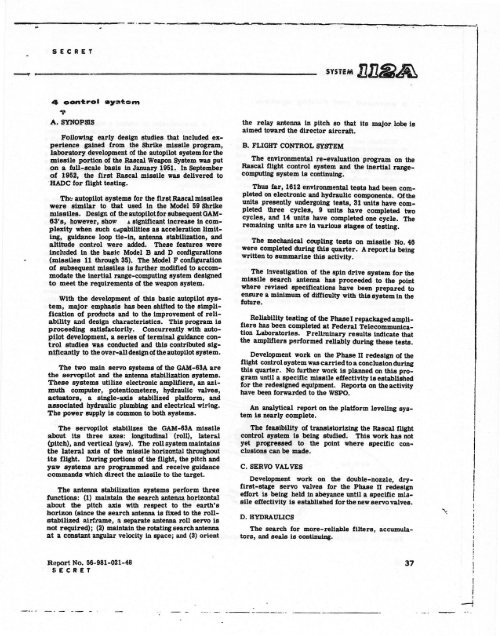System 112A - The Black Vault
System 112A - The Black Vault
System 112A - The Black Vault
Create successful ePaper yourself
Turn your PDF publications into a flip-book with our unique Google optimized e-Paper software.
~-------------------.----~.--------~------------------------~--~,--~------,<br />
..<br />
SECRET<br />
---------------------------------------<br />
4 oontrol .ylS~~rn<br />
".<br />
A. SYNOPSIS<br />
Following early design studies that included experience<br />
gained from the Shrike missile program,<br />
laboratory development of the autopilot systemfor the<br />
missUe portion of the Rascal Weapon <strong>System</strong> was put<br />
on a full-scale basis in January 1951. In September<br />
of 1952, the first Rascal missile was dellvered to<br />
HADe for filght testing.<br />
Th~ autopilot systems for the first Rascal misslles<br />
were Similar to that used in the Model 59 Shrike<br />
missUes. Deslgr. of the autopllotfor subsequent GAM-<br />
63's, however, show .& significant increase in complexity<br />
when such cclpablllties as acceleration limiting,<br />
guidance loop tie-in, antenna stab1llzatlon, and<br />
altltude control were added. <strong>The</strong>se features were<br />
included in the basic Model B and D configurations<br />
(missiles 11 through 35). <strong>The</strong> Model F configuration<br />
of subsequent misslles is further modified to accommodate<br />
the inertial range-computing system designed<br />
to meet the requirements of the weapon system.<br />
With the development of this basiC autopUot system,<br />
major emphasis has been shifted to the simplification<br />
of products and to the improvement of reUab1l1ty<br />
;md design characteristics. This program is<br />
proceeding satisfactorily. Concurrently with autopilot<br />
development, a series of terminal guidance control<br />
studies was conducted and this contributed significantly<br />
to the ovar-aU design of the autopilot system.<br />
<strong>The</strong> two main servo systems of the GAM-63A are<br />
the servopUot and the antellJUl stab1l1zatlon systems.<br />
<strong>The</strong>se systems utll1ze electronic amplifiers, an azimuth<br />
computer, potentiometers, hydraulic valves,<br />
actuators, a single-axis stablllzed platform. and<br />
associated hydraulic plumbing and electrical wtr ~ng.<br />
<strong>The</strong> power supply is common to both systems.<br />
<strong>The</strong> servopllot stablllzes the GAM-63A missile<br />
about its three axes: longitudinal (roll), lateral<br />
(pitch), and vertical (yaw). <strong>The</strong> rollsystemmaintalns<br />
the lateral axls of the missile horizontal throughout<br />
its flight. During portions of the flight, the pitch and<br />
yaw systems are programmed and receive guidance<br />
commands which direct the missile to the target.<br />
<strong>The</strong> antenna stablllzatlon systems perform three<br />
functions: (1) maintain the search anteMa horizontal<br />
about the pitch axls with respect to the earth's<br />
horizon (since the search antenna is fixed to the rollstabllized<br />
a!rfl"ame, a separate antenna roll servo is<br />
Dot required); (2) maintain the rotating searchantenna<br />
at a constant angular velocity in space; and (3) orient<br />
the relay antenna in pitch so that its major lobe is<br />
aimed toward the director aircraft.<br />
B. FLIGHT CONTROL SYSI'EM<br />
<strong>The</strong> environmental re-evaluatlon program on the<br />
Rascal fllght control system and the inertial rangecomputing<br />
system is continuing.<br />
Thus far, 1612 environmental tests had been completed<br />
on electronic and hydraulic components. Of the<br />
units presently IUtdergoing tests, 31 units have completed<br />
three cycles, 9 units have completed two<br />
cycles, and 14 units have completed one cycle. <strong>The</strong><br />
remaining units art'! in various stages of testing.<br />
<strong>The</strong> mechanical coupling tests on missUe No. 46<br />
were completed during this quarter. A report ill being<br />
written to summarize this activity.<br />
<strong>The</strong> Investigation of the spin drive system for the<br />
misslle search antenna has proceeded to the point<br />
where revised specifications have been prepared to<br />
ensure a minimum of difficulty with this system tn the<br />
future.<br />
Reliabll1ty testlDg of the PhaseI repackaged amplifiers<br />
has been completed at Federal Telecommunication<br />
Laboratories. Preliminary results indicate that<br />
the ampilliers performed rellably during these tests.<br />
Development work on the Phase n redesign of the<br />
fUght control system was carriedto a conclusion during<br />
this quarter. No further work is pla.nned on this program<br />
untll a specific missUe effectivity is establlshed<br />
for the redesigned equipment. Reports on the actlvity<br />
have been forwarded to the WSPO.<br />
An analytical report on the platform levellng system<br />
is nearly complete.<br />
<strong>The</strong> feasibUity of transistorizing the Rascal fUght<br />
control system is being studied. This work has not<br />
yet progressed to the point where specifiC conclusions<br />
can be made.<br />
C. SERVO VALVES<br />
Development work on the double-nozzle, dryfirst-stage<br />
servo valves for the Phase n redesign<br />
effort is being held in abeyance until a specific mlasUe<br />
effectivity is establlshed for the new servo valves.<br />
D. HYDRAULICS<br />
<strong>The</strong> eearch for more-rellable fUters, accumulators,<br />
and seals Is contlnulng.<br />
R,~port No. 56-981-021-48<br />
!iECRET<br />
37<br />
--t<br />
I
















